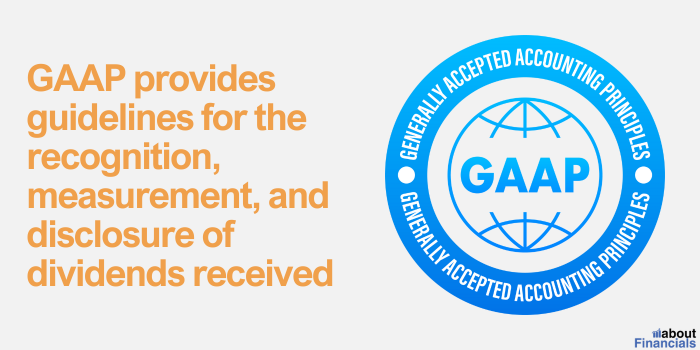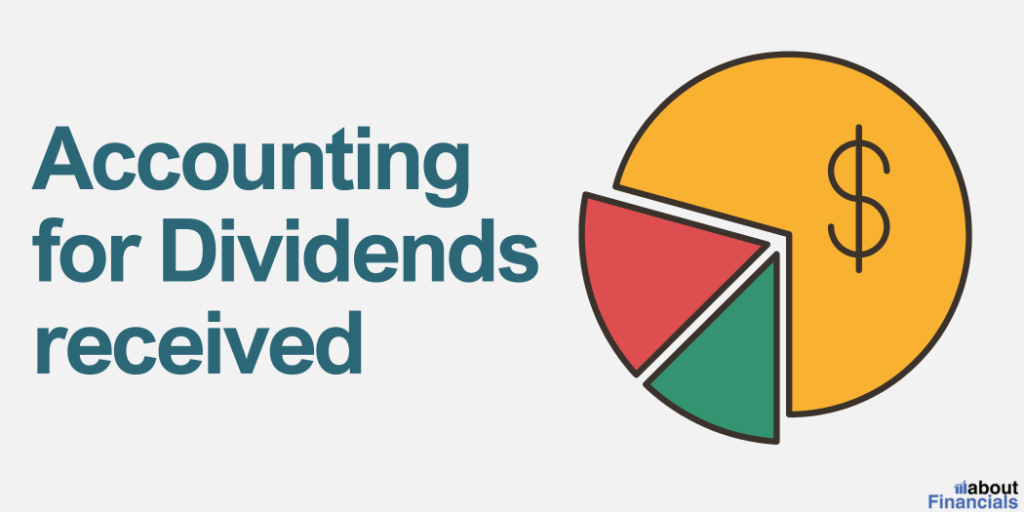When a company generates profits, it often distributes a portion of those earnings to its shareholders in the form of dividends.
Dividends are typically paid out in cash, but they can also be issued as additional shares of stock or other forms of property.
Dividends received by shareholders serve as a reward for their investment and provide a direct financial benefit.
They represent a share in the profits earned by the company and can contribute significantly to an investor’s overall returns. Consequently, understanding the accounting treatment for dividends received is essential for accurate financial reporting.
Recognition of Dividends Received
Dividends received from subsidiary
In certain cases, a company may have subsidiary entities in which it holds a controlling interest.

Dividends received from such subsidiaries are known as intercompany dividends. From an accounting perspective, the recognition of intercompany dividends follows specific guidelines.
When a subsidiary declares a dividend, the parent company recognizes its share of the dividend as income.
This recognition occurs on the date the subsidiary declares the dividend, regardless of when it is actually paid. The parent company’s share of the dividend is typically based on its ownership percentage in the subsidiary.
Dividends received from investments
Companies may also earn dividends from other investments in equity instruments, such as stocks of other companies.
The accounting treatment for dividends received from these investments depends on the nature of the investment and the applicable accounting standards.
If the investment is classified as available-for-sale or held-to-maturity, dividends received are generally recognized as income when they are declared.
On the other hand, if the investment is classified as trading, dividends received are recognized as income when they are earned.
Dividends received on preferred stock
Preferred stock is a type of equity security that carries preferential rights, including the right to receive dividends before common stockholders.
When a company receives dividends on preferred stock, the accounting treatment differs from that of dividends received on common stock.
Dividends received on preferred stock are typically recognized as income on the date they are declared.
This is because preferred stockholders have a fixed dividend rate or a predetermined formula for calculating their dividends, making the timing of recognition more certain.
Criteria for recognizing dividends received
To recognize dividends received, certain criteria need to be met.

The key criterion is the right to receive the dividend, which is typically established when the dividend is declared by the issuing entity.
The actual receipt of cash or other assets may occur at a later date, but recognition occurs when the right to receive the dividend is established.
Accounting Treatment for Dividends Received
Classification of dividends received
Dividends received are classified as income and are typically recorded as such in the financial statements. The exact classification may depend on the nature of the dividend and the reporting requirements of the accounting standards being followed.
For example, dividends received from subsidiaries may be classified as “Dividend Income” or “Income from Investments.”
Dividends received from other equity investments may be classified under similar categories, reflecting the source of the dividend.
Journal entry for recording dividends received

The journal entry to record dividends received involves debiting the cash or receivables account and crediting the dividend income account. The specific accounts used may vary based on the company’s chart of accounts and the nature of the dividend.
Here’s an example of a journal entry for recording dividends received:
Debit: Cash or Receivables Account
Credit: Dividend Income Account
This entry reflects the increase in the cash or receivables balance and recognizes the dividend income earned by the company.
Impact on the balance sheet
Dividends received have an impact on the company’s balance sheet. The cash or receivables account increases as a result of receiving the dividend, leading to a higher cash or receivables balance.
Additionally, if the company holds investments in subsidiaries or other equity instruments, the value of those investments may be affected by the dividends received.
For example, if the company owns stock in another entity and receives dividends on that stock, it may result in an increase in the investment’s fair value.
Impact on the income statement
Dividends received are recorded as income in the income statement, contributing to the company’s overall revenue and profitability. The dividend income is typically reported under an appropriate category, such as “Other Income” or “Non-operating Income.”
The inclusion of dividends received in the income statement helps to reflect the company’s investment activities and their impact on financial performance.
Reporting Dividends Received
Disclosures in financial statements
Financial statements should provide relevant disclosures regarding dividends received. These disclosures aim to provide transparency and help users of the financial statements understand the nature and impact of dividends received on the company’s financial position.
The specific disclosures may vary depending on the reporting framework and applicable accounting standards. Some common disclosures related to dividends received include:
Presentation in the income statement
Dividends received are typically presented as a separate line item in the income statement, reflecting the income earned from the dividends. The exact presentation may vary depending on the reporting requirements and presentation format chosen by the company.
It’s common to include dividends received under a specific category, such as “Dividend Income” or “Income from Investments.” This helps users of the financial statements identify the sources of income and understand the impact of dividends received on the company’s financial performance.
Presentation in the statement of cash flows
Dividends received are presented in the statement of cash flows to provide insights into the cash flow activities of the company. Dividends received are typically categorized as operating cash inflows since they represent a return on investment and are directly related to the company’s primary operations.
The statement of cash flows should include a separate line item or disclose the amount of dividends received under the “Operating Activities” section. This helps users of the financial statements assess the cash-generating capacity of the company through its investment activities.
Accounting Standards and Guidelines
GAAP requirements for accounting for dividends received
Under Generally Accepted Accounting Principles (GAAP), the recognition and accounting treatment for dividends received are guided by specific principles and standards.

GAAP provides guidelines for the recognition, measurement, and disclosure of dividends received. These guidelines ensure consistency and comparability in financial reporting across different entities.
IFRS requirements for accounting for dividends received
International Financial Reporting Standards (IFRS) also provide principles and guidelines for accounting for dividends received. Companies following IFRS must apply these standards to ensure the accuracy and transparency of their financial statements.
IFRS provides guidance on the recognition, measurement, and presentation of dividends received. Again, the objective is to ensure the relevance, reliability, and comparability of financial information reported by companies operating in different jurisdictions.
Examples of dividends received
Example transactions and their accounting treatment
To better understand the accounting for dividends received, let’s consider a few examples:
Example 1: Dividends received from a subsidiary
Suppose Company A owns 80% of the shares of Company B, its subsidiary. Company B declares a dividend of $10,000. The accounting treatment for Company A would be to recognize its share of the dividend as income. Assuming no withholding taxes, Company A would record the following journal entry:
Debit: Cash or Receivables Account ($8,000)
Credit: Dividend Income Account ($8,000)
Example 2: Dividends received from an equity investment
Company X holds 1,000 shares of Company Y’s stock and receives a dividend of $2 per share. The accounting treatment for Company X would be to recognize the dividend as income. The journal entry would be:
Debit: Cash or Receivables Account ($2,000)
Credit: Dividend Income Account ($2,000)
Some commons questions about dividends received
How are record dividends received recorded in the accounting records?
Dividends received are recorded in the accounting records through a journal entry. The specific accounts used may vary based on the company’s chart of accounts and the nature of the dividend. Typically, the cash or receivables account is debited to reflect the increase in cash or receivables, while the dividend income account is credited to recognize the income earned from the dividends.
Is dividends received an income or asset?
Dividends received are considered income for the recipient company. They represent a return on investment and are recognized as revenue in the income statement. Dividends received are not recorded as assets since they are a distribution of profits rather than an increase in the company’s resources.
Where do dividends received appear in the financial statements?
Dividends received typically appear in the income statement as a separate line item, such as “Dividend Income” or “Income from Investments.” This line item reflects the income earned from the dividends received during the reporting period. Additionally, the total amount of dividends received may be disclosed in the notes to the financial statements to provide additional information.
What is the double entry for dividends received?
The double entry for dividends received involves a debit to the cash or receivables account and a credit to the dividend income account. This entry reflects the increase in the cash or receivables balance and recognizes the income earned from the dividends received.
Where do dividends go on a balance sheet?
Dividends do not appear on the balance sheet since they are distributions of profits rather than assets or liabilities. Dividends are recorded in the income statement as a reduction of retained earnings, which is a component of shareholders’ equity. The decrease in retained earnings due to dividends is usually disclosed in the statement of changes in equity or in the notes to the financial statements.
Do dividends affect net income?
Dividends do not affect net income. Net income is calculated before the deduction of dividends. Dividends are paid out of the retained earnings, which represent accumulated profits. The payment of dividends reduces the retained earnings but does not impact the calculation of net income.
Is a dividend a debit or credit?
In accounting, dividends are neither a debit nor a credit. Instead, the recording of dividends involves a debit to the cash or receivables account (to increase the cash balance) and a credit to the dividend income account (to recognize the income earned from the dividends). The debit and credit entries represent the dual effect of the transaction on the company’s accounts.
Final thoughts
Accurate accounting for dividends received is crucial for providing transparent and reliable financial information.
By following the appropriate accounting principles, companies can ensure the proper recognition, recording, and reporting of dividends received, thereby enhancing the understanding and decision-making of financial statement users.
Related posts:

